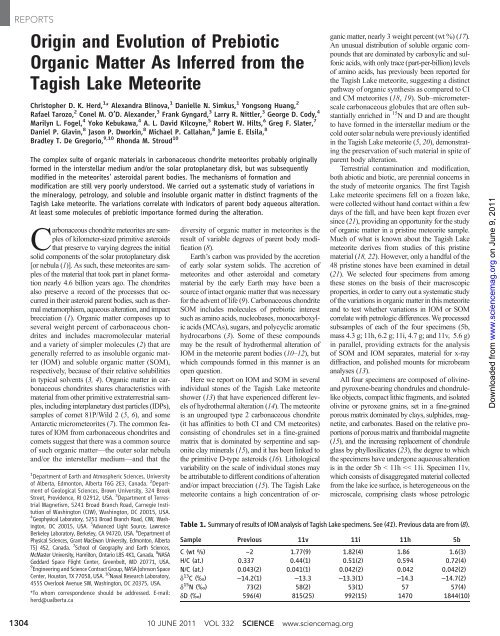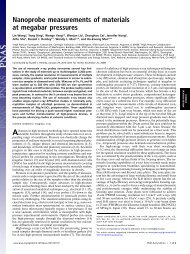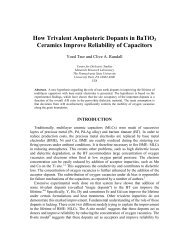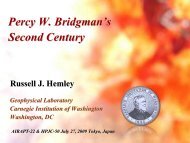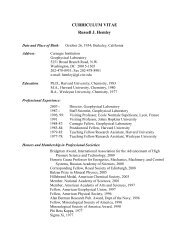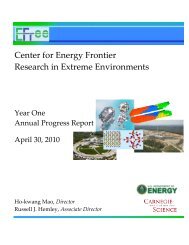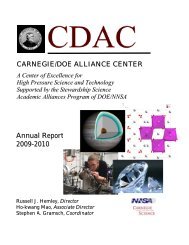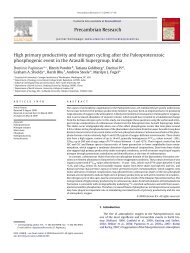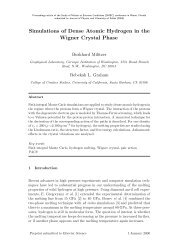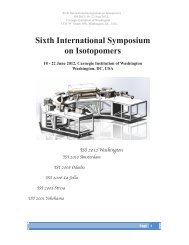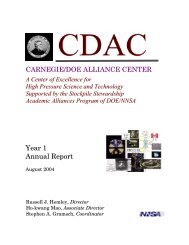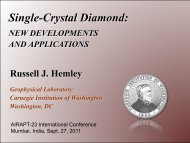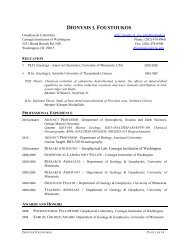Herd C. D. K., A. Blinova, D. N. Simkus, Y. Huang, R. Tarozo, C. M. O ...
Herd C. D. K., A. Blinova, D. N. Simkus, Y. Huang, R. Tarozo, C. M. O ...
Herd C. D. K., A. Blinova, D. N. Simkus, Y. Huang, R. Tarozo, C. M. O ...
Create successful ePaper yourself
Turn your PDF publications into a flip-book with our unique Google optimized e-Paper software.
REPORTS<br />
Origin and Evolution of Prebiotic<br />
Organic Matter As Inferred from the<br />
Tagish Lake Meteorite<br />
Christopher D. K. <strong>Herd</strong>, 1 * Alexandra <strong>Blinova</strong>, 1 Danielle N. <strong>Simkus</strong>, 1 Yongsong <strong>Huang</strong>, 2<br />
Rafael <strong>Tarozo</strong>, 2 Conel M. O’D. Alexander, 3 Frank Gyngard, 3 Larry R. Nittler, 3 George D. Cody, 4<br />
Marilyn L. Fogel, 4 Yoko Kebukawa, 4 A. L. David Kilcoyne, 5 Robert W. Hilts, 6 Greg F. Slater, 7<br />
Daniel P. Glavin, 8 Jason P. Dworkin, 8 Michael P. Callahan, 8 Jamie E. Elsila, 8<br />
Bradley T. De Gregorio, 9,10 Rhonda M. Stroud 10<br />
The complex suite of organic materials in carbonaceous chondrite meteorites probably originally<br />
formed in the interstellar medium and/or the solar protoplanetary disk, but was subsequently<br />
modified in the meteorites’ asteroidal parent bodies. The mechanisms of formation and<br />
modification are still very poorly understood. We carried out a systematic study of variations in<br />
the mineralogy, petrology, and soluble and insoluble organic matter in distinct fragments of the<br />
Tagish Lake meteorite. The variations correlate with indicators of parent body aqueous alteration.<br />
At least some molecules of prebiotic importance formed during the alteration.<br />
Carbonaceous chondrite meteorites are samples<br />
of kilometer-sized primitive asteroids<br />
that preserve to varying degrees the initial<br />
solid components of the solar protoplanetary disk<br />
[or nebula (1)]. As such, these meteorites are samples<br />
of the material that took part in planet formation<br />
nearly 4.6 billion years ago. The chondrites<br />
also preserve a record of the processes that occurred<br />
in their asteroid parent bodies, such as thermal<br />
metamorphism, aqueous alteration, and impact<br />
brecciation (1). Organic matter composes up to<br />
several weight percent of carbonaceous chondrites<br />
and includes macromolecular material<br />
and a variety of simpler molecules (2) that are<br />
generally referred to as insoluble organic matter<br />
(IOM) and soluble organic matter (SOM),<br />
respectively, because of their relative solubilities<br />
in typical solvents (3, 4). Organic matter in carbonaceous<br />
chondrites shares characteristics with<br />
material from other primitive extraterrestrial samples,<br />
including interplanetary dust particles (IDPs),<br />
samples of comet 81P/Wild 2 (5, 6), and some<br />
Antarctic micrometeorites (7). The common features<br />
of IOM from carbonaceous chondrites and<br />
comets suggest that there was a common source<br />
of such organic matter—the outer solar nebula<br />
and/or the interstellar medium—and that the<br />
1 Department of Earth and Atmospheric Sciences, University<br />
of Alberta, Edmonton, Alberta T6G 2E3, Canada. 2 Department<br />
of Geological Sciences, Brown University, 324 Brook<br />
Street, Providence, RI 02912, USA. 3 Department of Terrestrial<br />
Magnetism, 5241 Broad Branch Road, Carnegie Institution<br />
of Washington (CIW), Washington, DC 20015, USA.<br />
4 Geophysical Laboratory, 5251 Broad Branch Road, CIW, Washington,<br />
DC 20015, USA. 5 Advanced Light Source, Lawrence<br />
Berkeley Laboratory, Berkeley, CA 94720, USA. 6 Department of<br />
Physical Sciences, Grant MacEwan University, Edmonton, Alberta<br />
T5J 4S2, Canada. 7 School of Geography and Earth Sciences,<br />
McMaster University, Hamilton, Ontario L8S 4K1, Canada. 8 NASA<br />
Goddard Space Flight Center, Greenbelt, MD 20771, USA.<br />
9 Engineering and Science Contract Group, NASA Johnson Space<br />
Center, Houston, TX 77058, USA. 10 Naval Research Laboratory,<br />
4555 Overlook Avenue SW, Washington, DC 20375, USA.<br />
*To whom correspondence should be addressed. E-mail:<br />
herd@ualberta.ca<br />
diversity of organic matter in meteorites is the<br />
result of variable degrees of parent body modification<br />
(8).<br />
Earth’s carbon was provided by the accretion<br />
of early solar system solids. The accretion of<br />
meteorites and other asteroidal and cometary<br />
material by the early Earth may have been a<br />
source of intact organic matter that was necessary<br />
for the advent of life (9). Carbonaceous chondrite<br />
SOM includes molecules of prebiotic interest<br />
such as amino acids, nucleobases, monocarboxylic<br />
acids (MCAs), sugars, and polycyclic aromatic<br />
hydrocarbons (3). Some of these compounds<br />
may be the result of hydrothermal alteration of<br />
IOM in the meteorite parent bodies (10–12), but<br />
which compounds formed in this manner is an<br />
open question.<br />
Here we report on IOM and SOM in several<br />
individual stones of the Tagish Lake meteorite<br />
shower (13) that have experienced different levels<br />
of hydrothermal alteration (14). The meteorite<br />
is an ungrouped type 2 carbonaceous chondrite<br />
(it has affinities to both CI and CM meteorites)<br />
consisting of chondrules set in a fine-grained<br />
matrix that is dominated by serpentine and saponite<br />
clay minerals (15), and it has been linked to<br />
the primitive D-type asteroids (16). Lithological<br />
variability on the scale of individual stones may<br />
be attributable to different conditions of alteration<br />
and/or impact brecciation (15). The Tagish Lake<br />
meteorite contains a high concentration of organic<br />
matter, nearly 3 weight percent (wt %) (17).<br />
An unusual distribution of soluble organic compounds<br />
that are dominated by carboxylic and sulfonic<br />
acids, with only trace (part-per-billion) levels<br />
of amino acids, has previously been reported for<br />
the Tagish Lake meteorite, suggesting a distinct<br />
pathway of organic synthesis as compared to CI<br />
and CM meteorites (18, 19). Sub–micrometerscale<br />
carbonaceous globules that are often substantially<br />
enriched in 15 N and D and are thought<br />
to have formed in the interstellar medium or the<br />
cold outer solar nebula were previously identified<br />
in the Tagish Lake meteorite (5, 20), demonstrating<br />
the preservation of such material in spite of<br />
parent body alteration.<br />
Terrestrial contamination and modification,<br />
both abiotic and biotic, are perennial concerns in<br />
the study of meteorite organics. The first Tagish<br />
Lake meteorite specimens fell on a frozen lake,<br />
were collected without hand contact within a few<br />
days of the fall, and have been kept frozen ever<br />
since (21), providing an opportunity for the study<br />
of organic matter in a pristine meteorite sample.<br />
Much of what is known about the Tagish Lake<br />
meteorite derives from studies of this pristine<br />
material (18, 22). However, only a handful of the<br />
48 pristine stones have been examined in detail<br />
(21). We selected four specimens from among<br />
these stones on the basis of their macroscopic<br />
properties, in order to carry out a systematic study<br />
of the variations in organic matter in this meteorite<br />
and to test whether variations in IOM or SOM<br />
correlate with petrologic differences. We processed<br />
subsamples of each of the four specimens (5b,<br />
mass 4.3 g; 11h, 6.2 g; 11i, 4.7 g; and 11v, 5.6 g)<br />
in parallel, providing extracts for the analysis<br />
of SOM and IOM separates, material for x-ray<br />
diffraction, and polished mounts for microbeam<br />
analyses (13).<br />
All four specimens are composed of olivineand<br />
pyroxene-bearing chondrules and chondrulelike<br />
objects, compact lithic fragments, and isolated<br />
olivine or pyroxene grains, set in a fine-grained<br />
porous matrix dominated by clays, sulphides, magnetite,<br />
and carbonates. Based on the relative proportions<br />
of porous matrix and framboidal magnetite<br />
(15), and the increasing replacement of chondrule<br />
glass by phyllosilicates (23), the degree to which<br />
the specimens have undergone aqueous alteration<br />
is in the order 5b < 11h


